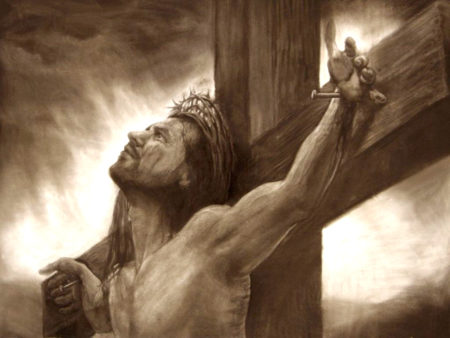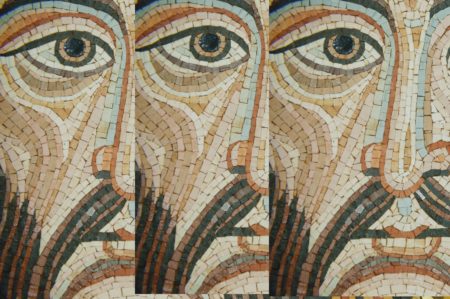At tritheistblog, tritheist Steve Hays interacts with my critique of his Incarnation theory. He’s comically aggressive and insulting, but he does, for once, point out a mistake on my part, which I’ll own. He’d said,
The Incarnation is a union between the timeless, incorporeal Son, a mind in time, and a body in space.
Which I interpreted as,
The Incarnation is a union between the timeless, incorporeal Son (a mind in time), and a body in space.
Do you see the difference? I thought I was seeing the Athanasian model of Incarnation: Logos + body, but really, he holds to the more typical three part view: Logos + human (or rational) soul + human body. I of course saw that view too in his post – but I don’t put it past a theorist of his caliber to have competing theories rammed into one incoherent account. Still, in this case, it turns out that I should have tried harder to read him as holding one view, because he is in fact a three-part theorist about Incarnation.
 Much of his post is dreary fussing over terms or shameful vituperation. Out of kindness to both him and you, I omit all of that, and a few of his idiosyncratic speculations, and some mildly helpful clarifications of his terms.
Much of his post is dreary fussing over terms or shameful vituperation. Out of kindness to both him and you, I omit all of that, and a few of his idiosyncratic speculations, and some mildly helpful clarifications of his terms.
The heart of my objection was that his Incarnation theory seems to involve three Jesuses, three selves which might be called “Jesus” or “the Son of God” – the Logos (an eternal god, an individual with all the divine attributes), the man, and the composite of the two. What does he say that actually addresses this charge?
First, Hays stakes his claim on the composite – that which consists of Logos+soul+body:
Jesus is a composite being.
And he adds,
In my theology, God is timeless. Therefore, each member of the Trinity is timeless.
I had said, “This would be hard to square with the Son of the Bible, who is constantly changing.”
The human nature of Christ undergoes change. His human mind and body are temporally conditioned. The Son does not undergo change. The Incarnation involves a union between something mutable (human nature) and something immutable (divine nature).
 This “human nature” – what sorts of changes would it have to undergo? Being conceived, then born. Sleeping and rising. Getting hungry, eating, feeling full. Getting mad then calming down. Feeling sad then feeling better. Making choices and carrying them out. Learning new things. Growing up mentally and physically. Talking to God and sometimes hearing back. Receiving direction from God and then acting on it. Eventually, dying.
This “human nature” – what sorts of changes would it have to undergo? Being conceived, then born. Sleeping and rising. Getting hungry, eating, feeling full. Getting mad then calming down. Feeling sad then feeling better. Making choices and carrying them out. Learning new things. Growing up mentally and physically. Talking to God and sometimes hearing back. Receiving direction from God and then acting on it. Eventually, dying.
Only a man, a real human being can do all these things. What Hays, following catholic traditions, is calling “the human nature of Christ” is what any of us would call a man, a human self. Hence, we’re up to two Jesuses – the man, and the combination of the man and the Logos (in his view, an individual with all the divine attributes – so, what any of us would normally call “a god”). And then, of course, there is that Logos – the eternal Son of Trinity theories.
 So yeah, there are your three Jesuses.We could call them the man, the god, and the godman, or if you like Jesus, the Logos, and the Composite Christ. How do we know they’re three? They’re different from each other. The man (that combo of body and soul) started to exist roughly two thousand years ago. The Logos always existed. And the Composite Christ, unlike either of the others, has both a “divine nature” and a “human nature.”
So yeah, there are your three Jesuses.We could call them the man, the god, and the godman, or if you like Jesus, the Logos, and the Composite Christ. How do we know they’re three? They’re different from each other. The man (that combo of body and soul) started to exist roughly two thousand years ago. The Logos always existed. And the Composite Christ, unlike either of the others, has both a “divine nature” and a “human nature.”
Let’s see if Hays does anything to try to get the number back down to one, where it should be.
The Son qua Son isn’t Jesus. The Son qua Incarnate is Jesus. The Son isn’t one Jesus in addition to a second Jesus. The Son is a person of the Godhead in union with a rational soul and body. The result is Jesus.
This descent into as-talk isn’t easy to parse! If I understand him, by “the Son” he means the Logos – this “as Incarnate” is the godman, the Composite Christ. He’s saying that the god and the godman are the same self. It’s hard to see how that could be, when they’re not the same being! Remember, the first existed long before the second. The first isn’t composite, but the second is. And he can’t say that the first changed into the second, as in his view, the first can’t change.
The union produced a complex person. In a sense, Jesus has a human mind and a divine mind, but the relation is asymmetrical…
He tells us that the Logos coming together with the man (“human nature”) “produced” the godman, and then he expostulates on this godman having two minds. But this godman is in his words, a “person,” and it doesn’t seem like it’d be the same person as either the Logos or the man, because it’s not the same being as either. In his view, the Logos existed long before the other two, so it ain’t either of them. And the godman, in his view, has two minds, but the man (what he calls “the human nature”) in his view does not ever have two minds. So, he has three selves in this picture, three Jesuses.
Jesus just is the composite. There is no Jesus apart from the composite. There is no Jesus separate from the Incarnation. There is no human Jesus who preexisted the Incarnation, who existed apart from the Son, with whom the Son subsequently formed a union. The Incarnation occurs at the moment of conception. That’s when Jesus comes into being. The Son is ontologically independent of human nature he assumes. The human nature is dependent on the union.
Here, he insists that “Jesus” should mean the composite Christ, the godman. He distinguishes this person from the preexisting Son (the Logos, a god). Hays says that Jesus here comes into being, whereas in his view the Son is eternal. So he embraces two Jesuses here, one which is eternal, and one which comes to exist, as it were, late in time. But he wants to stop it there:
Although human nature can, and generally does, exist apart from Incarnation, this individualized human nature only exists in virtue of the Incarnation.
Here, he’s free-wheeling, and the suggestion makes no sense. If there is a union of A and B, this logically presupposes that both A and B exist. So it can’t be that B exists only because of the union. But maybe he’s speaking loosely here, and what he really means is that this “human nature” was brought into being solely for the purpose of this union with the Logos (the eternal Son).
Be that as it may, remember that this “individualized human nature” is what any person of common sense would call a man. It is born, it nurses, it eats and poops, in learns, rejoices, worries, cries, loves, chooses, prays, dies. It doesn’t matter if (as Hays speculates) this fellow exists because of the union of that soul and body with the Logos. It exists, and is a different being, and so a different self than the Logos or the Composite Christ. It’s a third Jesus.
I’d said, “No doubt, Hays thinks this is what died on the cross, so again, a man, not a property, and not merely an aggregate of soul and body.”
 What died on the cross was the body of Jesus.
What died on the cross was the body of Jesus.
This makes no sense for a dualist to say. It is the man, the human self who dies, not only his body – whether you think the man is the soul, or the composite formed of soul and body. Only a physicalist about human persons, who thinks that a human person just is a body, should think that a body can die a human death, the death of a human being. (More on the “What dies?” problem for Incarnation theories here.)
But in any case, the NT records the one called “Jesus” undergoing numerous changes. For Hays, “Jesus” must refer to the Composite Christ. But one part of this, the Logos, is fully divine and so (in Hays’s view) can’t change in any way, being timeless. So if the Composite changes, it must be in virtue of the other part, the “human nature.” It is this which undergoes all the changes that a typical human does, short of changing from not-sinning to sinning, and so which must be a man, a human self. Hays has not given us any reason to think that this “human nature” that does all of these things is any thing less than a man.

Thus, Hays is a tri-Jes-ist. He doesn’t want to be one. And he’s not the only one. But, he is one.
What people should be wondering is whether or not the Bible really requires more than one Jesus.
If you think that it really does require these three selves, take your New Testament, and locate all the terms like “the Son of God,” “Jesus,” “Christ,” “the Lord Jesus,” and so on – and try to color-code them by which “Jesus” the author must have meant – the man, the god, or the godman. Try to disambiguate all the Jesus-talk there, and see how that goes.

The human mind is confused and lost in the perpetual quest to understand God’s mystery of the incarnation. I feel sorry for you guys, you keep on wandering in the desert around the same mountain failing to arrive in the promised land. May God bestow His mercy upon your weary souls and reveal to you the mystery of oneness. The problem is not in your philosophical reasoning, but the problem is in original definitions of terms (Trinity, son, man etc. etc.). Before you even start to reason you already set up to fail, that is why we keep on going in a circle. WE HAVE FAULTY, POLLUTED, CONTAMINATED BASE!
Igor, if by “oneness” you mean modalism, then it seems to me that you have the same problem: Is Jesus one person or more than one? Is he both a human person and the one eternal God-person? Was it an impersonal human nature that prayed to the Father and called him “my God”? Or was it a human self who prayed to an eternal divine self? If the latter, then isn’t that two persons?
It is typical among Trinitarian thinkers to attempt to de-personize their concept of Jesus Human Nature who/which, since the time of Augustine, has been promoted as a ‘concrete nature’ . They do this in order to distance themselves from the Heresy of so-called Nestorianism which is understood as personizing the human nature of Jesus so as to conceptualize 2 persons of the Son. Trinitarian thinkers attempt an end run around the pertinent questions by endorsing the concept of enhypostasia, developed by Leontius of Byzantium, which basically posits that the concrete nature is hypostasized/personized in it’s instantiation by the Divine Son so that it does not have it’s own hypostasis. Thus may be what Mr Hays is referring to when he said “The human nature is dependent on the union.” and “his individualized human nature only exists in virtue of the Incarnation”.
But this just brings us back to pertinent questions – 1) how does a divine person, one instantiating all of the divine attributes (impassibility, simplicity, timelessness, immutability, etc.) become the active principal of a nature the exact opposite of his being?, since everything a divine person does requires adherence to his divine attributes. 2) Does the entity Jesus Christ truly constitute a part of God the Son? Since God the Son is a divine person, 3) if he/it is only accident, how can a divine person have an accident or add an accident to his person?
About a year ago Dale, I sent you an e-mail to your university e-mail regarding the defeaters used to deny the personhood of Jesus human nature. Did you ever receive it.?
respectfully
Reality checker
Comments are closed.